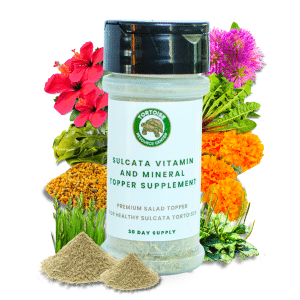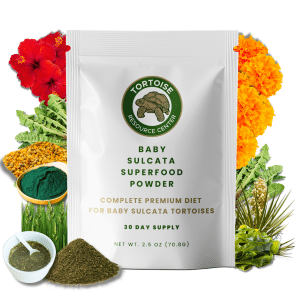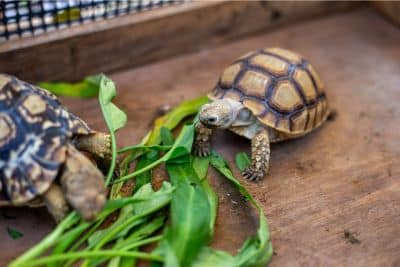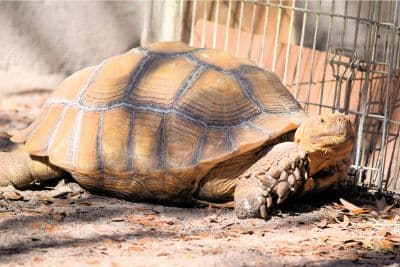Tortoises are reptiles that belong to the family Testudinidae of the order Testudines. This order also encompasses turtles and terrapins.
Testudines are characterized by hard shells that encase their soft bodies. Each type of reptile is somewhat similar in appearance, but their habitats and behaviours are very different.
For example, both turtles and terrapins have streamlined shells and webbed feet to aid swimming. On the other hand, tortoises have domed shells and elephant-like feet. Moreover, turtles and terrapins are also almost entirely aquatic and consume a variety of marine organisms, whereas tortoises live off mainly terrestrial vegetation.
There are around 49 species of tortoise, all of which are entirely terrestrial, and they frequent a wide variety of habitats across the globe. These habitats range from grasslands to deserts to rainforests.
Tortoises have been known to migrate across small islands around the world, despite the fact they cannot swim. This is because they can float on their shells and survive for long periods without food or water. As a result, tortoises have spread to isolated islands and over time have evolved and adapted to their environment.
Physical Adaptations
In terms of anatomy, tortoises are not built for swimming. Testudine shells follow the same basic structure as a ‘carapace’ and a ‘plastron’. Bony plates called ‘scutes’ cover the shell and act as a protective armor.
Due to their aquatic lifestyle, turtles have evolved smooth, streamlined shells. They shed their scutes to keep the shell thin, light and flat. Conversely, tortoise shells are heavy. They grow in a domed shape due to individual scutes growing on top of one another.
Tortoises are much larger and heavier than their aquatic counterparts. As such, tortoises have stocky, elephant-like limbs that are designed to carry their heavy body over various terrains.
On the other hand, the front limbs of turtles and terrapins have evolved into flippers to propel them through the water. Their back feet are webbed and act as rudders.
Turtles are able to regulate their buoyancy by adjusting the volume of air they inhale into their lungs above the surface before they dive. Turtles can hold their breath for as long as two hours, whereas tortoises can seldom hold their breath for more than a few minutes.
As for tortoises, It may seem surprising due to their size and weight, but they are buoyant. And although these creatures cannot swim, they are able to float across bodies of water.
Swimming Abilities
Turtles and terrapins are excellent swimmers, whereas tortoises do not have a natural aptitude for swimming. This is one of the major differences between the species, and determines their habitat, diet and lifestyle.
Due to their anatomy and physiology, tortoises are not built to live in the water. However, although they can’t swim, they are buoyant and able to float, though this is seldom observed.
It is widely accepted that floating is how tortoises have been able to colonize isolated islands. In fact, based on the barnacles that had grown on its limbs, scientists found a tortoise that had survived floating over 450 miles.
Risks of Water Exposure
Due to the fact, that tortoises do not possess the ability to swim, they can easily drown if they are submerged in deep water for extended periods of time. Moreover, prolonged exposure to water and very damp conditions can lead to shell rot and respiratory infections.
Conversely, tortoises can become dehydrated easily and they are especially vulnerable after hibernation. Just like overly saturated conditions, too dry conditions come with their own burden of health problems such as kidney problems, bladder stones, digestive issues and poor shell health and skin conditions.
Safe Access to Water
Since tortoises are unable to swim yet need access to water to stay healthy, there are a number of things that owners can do to keep them hydrated:
1. Provide access to Fresh Water
Place a shallow water container such as a saucer or jam jar in their enclosure. Ensure they have constant access to clean, fresh water and replenish the supply daily.
2. Bathe your tortoise regularly
Not only do tortoises hydrate themselves through drinking, but also absorb water through their skin, so baths are a great way to ensure your tortoise stays hydrated.
Are You Starving Your Tortoise?
Save 10% on premium tortoise food and supplements from Tortoise Resource Center on Amazon now using code BUYNOWGET10

Sulcata Vitamin & Mineral Topper Supplement
30-Day Supply | 2 oz (56 g)
$24.99

Baby Sulcata Tortoise Superfood Powder
30-Day Supply | 2.5 oz (70.8 g) Bag
$24.99
3. Keep humidity levels in check
The humidity requirements for your tortoise will vary depending on the species. For example, desert tortoises and Mediterranean tortoises need lower humidity levels compared to many forest species. Check out my care guide section on the homepage for information about specific species.
4. Offer hydrating foods with caution
If you suspect your tortoise is dehydrated, you can offer foods with high water content such as leafy greens and certain vegetables. Make this the exception rather than the rule as whilst they may offer immediate hydration, they often contain very little nutrition and can also cause digestive issues if consumed too often.
Caring for Tortoises Near Water
Sufficient moisture and hydration are critical for the survival of any tortoise species. As well as through drinking, tortoises get their water through the foods they eat and by absorbing water through their skin.
You should provide your tortoise with shallow water from which they can drink. Make sure the water is easily accessible and remain below head height to avoid drowning.
I also recommend soaking your tortoise a few times a week for 20 minutes, making sure to monitor them throughout the process.
The ‘bath’ should be a shallow dish of water placed in the enclosure and the water should not come higher than the chin of the tortoise, to avoid drowning. Additionally, the water should be sunk into the ground, surrounded by pebbles or substrate so your tortoise can easily get in and out.
Hatchlings can be bathed daily, and juveniles and adults should be bathed every 2-3 days in lukewarm water. Not only will this help to keep your tortoise hydrated, it also prompts them to empty their bladder and bowel as well as helping to keep them clean.
In addition to making sure the humidity levels are appropriate for your tortoise species, you will also need to maintain optimal environmental conditions.
Exact conditions depend on the specific tortoise species and you should refer to my care guide section for details for each tortoise type.
Citations
- UCDAVIS – soaking
- Britannica – tortoise
- Nashville Zoo – tortoise vs turtle
- NOAA – buoyancy


